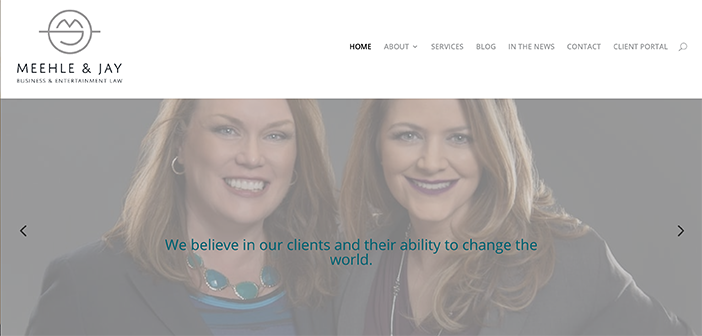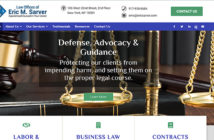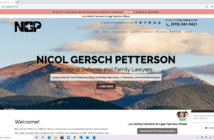Using these marketing strategies, Suzanne Meehle has built a practice that supplies a full range of legal services to small business owners.
It didn’t take Suzanne Meehle long after starting her own law firm to realize that making friends with other lawyers wouldn’t do her practice any good. Meehle launched her central Florida firm, now called Meehle & Jay, in 2009, after working as an associate in a large, multi-office firm for three years. She knew that, now that she was on her own, referrals from other attorneys would be “great to get,” but they “were going to be sparse given that I practice in the area of business law.”
Attorneys in law firms of any size “have got one of those down the hall and they’re going to refer internally,” Meehle says. “I quickly came to the conclusion that I needed to network with more than just lawyers. So I got involved with some of the business organizations that were in a position to introduce me to potential clients and to referral sources that were not attorneys.” That has worked wonders.
Business Involvement
Six years later, Meehle and the partner she took on in 2016, Davey Jay, are both deeply embedded in the Orlando area’s business and nonprofit world, as volunteers, members of boards, and presenters at conferences and seminars. Jay, a former ballet dancer, has focused on arts-oriented nonprofits. Meehle, a former software engineer, is on the board of directors of the Greater Sanford Regional Chamber of Commerce and a member of two other Orlando area chambers. She is also the current president of the Better Business Bureau of Central Florida, and is involved with Score, a small-business mentoring program. “Being on those boards has been really good for my business,” she says. “People can tell that you’re really involved and are trying to help the local business community, and that goes a long way.”
Meehle has also served on the boards of several social-service nonprofits including Hope and Help Center of Central Florida, an organization that helps meet the needs of people with HIV/AIDS. “I have done work for the organization as a volunteer for years and years,” says Meehle. Having gotten to know her through her volunteer work, the group eventually retained her as an attorney, and then asked if she would serve on the board.
Serving on the boards of nonprofits “hasn’t been great for business marketing per se. But if you give back to your community, people will take note of that,” says Meehle. “And it builds tremendous goodwill with my nonprofit clients when I agree to sit on their board. It helps them a lot to have an adviser in the room during meetings. Also the other board members tend to be business owners and professionals, and getting to know them has led to other clients.”
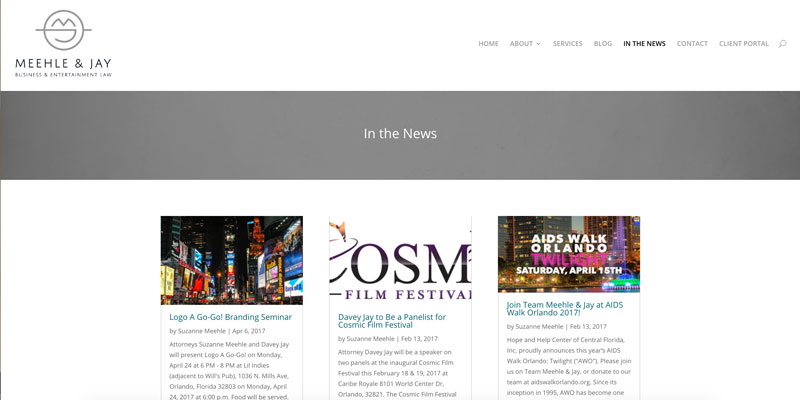
Tips for Putting on Successful Seminars
Meehle and Jay have found that an effective way to engage directly with potential clients is to speak at conferences, business events and at seminars they set up themselves. One they recently offered–free of charge, with free food and a cash bar–was about branding, catchily called Logo a Go-Go. They have also recently given presentations at a film festival, a music conference, a meeting of registered agents, and conference for women who own businesses.
A successful seminar, Meehle says, must have “a really compelling topic, something that business owners care about.” And it should be scheduled to suit the intended audience. “We have found almost universally that happy hours work great but breakfasts and lunches don’t work at all,” says Meehle. “Our clients tend to be the business owner, and they’re on the job all day, so doing it after hours makes a lot more sense. We pretty much have to have food and beverages, particularly adult beverages. If we have food and beverages, we will pack the house every time.”
“The other trick is that you can’t just have a great, big undefined topic targeted at anyone who wants to show up,” Meehle adds. “It has to be very much a targeted message for the particular audience. ‘Let me tell you about estate planning’ is not nearly as effective as ‘let’s talk about how, if you’re a business owner, estate planning dovetails with your exit strategy.’ ”

For her recent seminar on logos, “I wasn’t just going to say, ‘let’s talk about trademark law.’ Nobody would show up for that. I talked about how, if you create a brand and logos for other business owners, copyright law affects you.” That topic, tightly focused on copyright law from the creator’s standpoint, for an audience of marketing companies, graphic designers, web designers, and other creatives, presented from 6 to 8 p.m. with free food and cash bar, drew a good crowd.
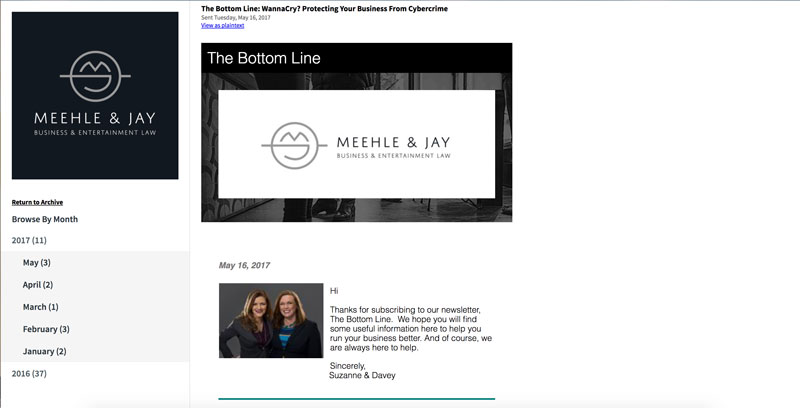
Free Business Law Primer
Meehle offers another freebie to visitors to the firm’s website — a copy of The Legal Primer for Business Owners: 3 Must-Take Actions to Build a Strong Foundation for a Profitable Business. Some visitors to the site “register to get the guide and then immediately unsubscribe, and that’s fine,” says Meehle. Those who stay registered “get our weekly email newsletter, and that’s the end of it. We’re not going to spam them with a bunch of unsolicited emails.” Meehle says she is “not sure anyone has ever hired us because of it. But clients will say how much they like the fact that we offer it. It is a trust-building kind of thing.”
Each issue of the newsletter, called The Bottom Line, follows the same format. At the top is a link to the latest article posted on the website’s blog. Each issue also includes a From the Archives feature highlighting an older blog post “that is still worth looking at,” followed by a newsy item, Out & About, often about the partners’ most recent public appearances. Another recurring item showcases one of the firm’s clients. “That is probably the most popular content we put in the newsletter,” Meehle says. Our clients love being featured. They get an uptick in traffic from people checking out their website. And we get a chance to tell our clients about another business that we’re working with.”
The newsletter items are repurposed as Twitter and Facebook posts. Meehle and Jay are active users of those platforms, with 2,700+ tweets and counting and 24 reviews on Facebook, all but one of them five-star endorsements. “According to Google Analytics, about one-third of our web traffic comes from social media,” says Meehle. “I have had clients hire me using Instant Messenger on Facebook. So I would definitely say it’s an effective marketing tool.”
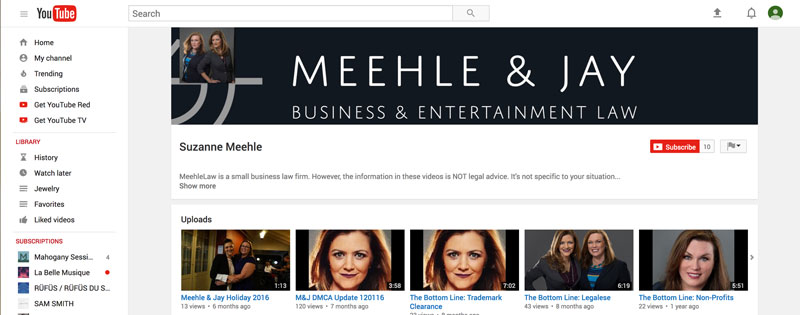
Experiments with Videos
Meehle has a YouTube channel stocked with videos in several different styles. She has done quickly-produced selfie videos for the firm’s Facebook page, shot with a cellphone camera, in which she delivers an extemporaneous riff on a legal issue, for instance one about the hazards of using legalese in business documents. Others have been professionally shot and edited for the firm’s website, such as one about choosing the most appropriate business entity for a new venture.
The expertly produced videos are “very much worth the time,” given the type of client the firm is seeking to attract, Meehle says. “We have a number of clients who are in the technology services and arts and entertainment field and they will definitely judge you by the quality of that video.”
Compelling videos are “a great way to keep people looking at you,” she adds. “Someone who otherwise wouldn’t spend five minutes on my website will listen to the entire video and spend five minutes that way. The visitor will hopefully end at the ‘contact us’ link because that is where they will find our phone number and location information. When analyzing our web traffic, we look at that flow. We can see that people who have engaged with our site for more than 60 or 90 seconds are more likely to click over to that link.”
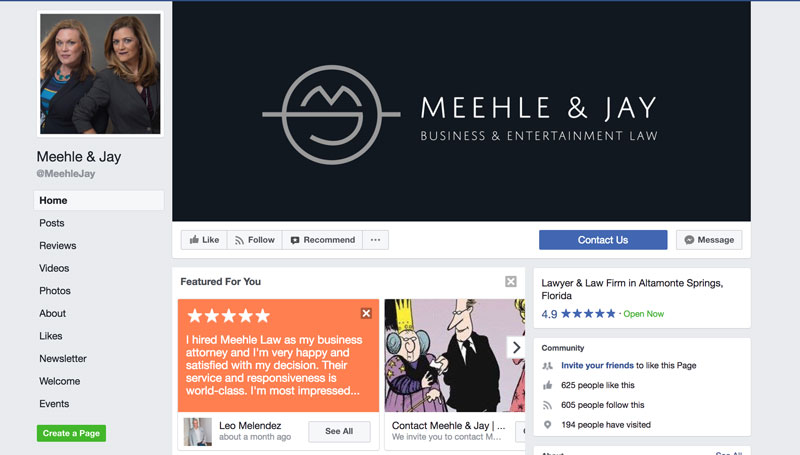
Serving a ‘Certain Type of Client’
Meehle seeks to differentiate her firm from others by emphasizing that she and her partner focus on meeting the needs of a “certain type of client,” small business owners, rather than specializing in a particular area of law. “I’ve done work for larger clients too, but as far as marketing goes, if I say I work with the little guy, my clients really like that,” she says. From business formation to litigation, from lease negotiations to estate planning, Meehle and Jay “want to be part of your support team through the life of your business,” the firm’s home page declares.
Meehle also strives to make her fees as predictable as possible, a practice inspired by her experience working in a large law firm. “I represented a number of small business clients and they all had the same question. Why can’t you tell me what it’s going to cost up front? Why am I getting these random bills: $250 one month, $2,000 the next? Why can’t you just make it predictable? I thought about it and I realized, I don’t know why we can’t. That was a lot of the impetus to go on my own in the first place.”
At the helm of her own firm, she is willing to provide transactional services that are reasonably standard for a flat fee. “We can always revisit that later if bigger issues come up,” Meehle says. “But if we’re saying that something is going to cost $1,000 and we do it and realize we really should have charged $1,200 or $1,500, we take the loss and it’s worth it. It builds trust with your clients if you do what you said you were going to do.” Charging flat fees for certain services is increasingly common, even with larger law firms, she says. “But it’s definitely a marketing advantage” for Meehle & Jay.
Startup Advice
Meehle was an entrepreneur before going into law and has worked closely with dozens of start-ups. Looking back with an objective eye on her own start-up in its early days, she can now see that her “biggest mistake” was spending too much on marketing at the outset. “Almost every dime” of her $10,000 marketing budget went straight to a large company that “was supposed to do web design and photography, and produce video and branding materials, and it took forever. We still didn’t have a website six months into it. When it was finally up and running, we didn’t have access to our backend.”
If she were doing it over again, she says, “I would not hire an expensive company to do my logo or my website. It’s much better to go a cheaper route and have some control over your website and content. I’m not saying do it yourself, but ask and know what you’re getting for your money.”
Her best move was doing a lot of advance work before making the leap. “I probably spent a good three months preparing to go on my own and not just financially preparing, but having a business plan and having basic starting documents. I had an engagement letter drafted, and an operating agreement. I knew how to open a trust account,” she says.
“We knew what it was going to take well before we started, so on Day One I was able to start marketing. And that involved making phone calls, and letting people know that I was now out on my own.” Attorneys seeking to follow in her footsteps should do the same thing, she says. “Be ready before Day One gets there.”

